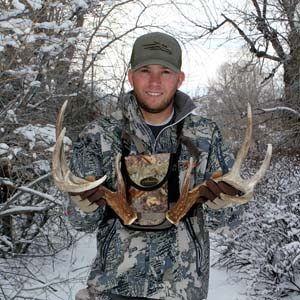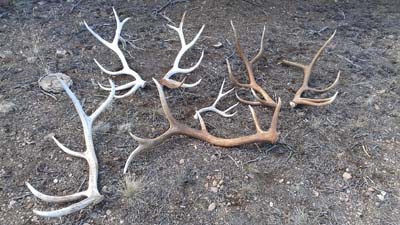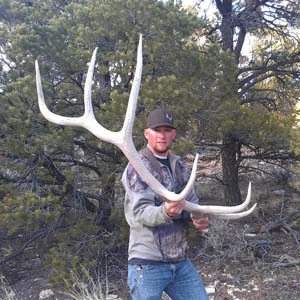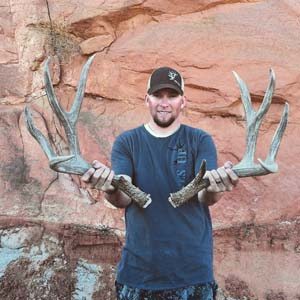I was introduced to shed hunting at a very early age. My brother and I would comb the hills looking for those brown treasures and back in those days, very few people were partaking in this activity. However, twenty years later, a lot has changed and now it is more than just a hobby. For many people, it is a way to make a living. One thing is for sure, the knowledge you can gain about your herd by shed hunting is instrumental in your fall success.
 If you are a hard-core trophy hunter, the primary reason to shed hunt is to see what animals have survived the hunting season, harsh winter, collisions with cars and those that have just plain survived. This will tell us a little bit about our inventory for the upcoming season. This is very important in a unit where you can have a tag in your pocket each and every year. It gives you the ability to watch a buck or bull grow up and see how they develop each and every year with the different conditions Mother Nature throws your direction. It also allows you to check your field judging ability to within a couple of inches when you are lucky enough to find those antlers.
If you are a hard-core trophy hunter, the primary reason to shed hunt is to see what animals have survived the hunting season, harsh winter, collisions with cars and those that have just plain survived. This will tell us a little bit about our inventory for the upcoming season. This is very important in a unit where you can have a tag in your pocket each and every year. It gives you the ability to watch a buck or bull grow up and see how they develop each and every year with the different conditions Mother Nature throws your direction. It also allows you to check your field judging ability to within a couple of inches when you are lucky enough to find those antlers.Spending time watching these animals right before they shed will allow you to learn something about their personalities and habits as well. When an animal gets to maturity and is on my hit list for the upcoming season, I usually have a couple sets of his sheds and know a great deal about him and his habits, which make him much more susceptible to harvest. One very important lesson I have learned with multiple years of sheds, is that they often don’t look as large as they really are when they get very mature. A mature mule deer buck might tip the scales at three hundred pounds when he is 7- or 8-years-old, but his 180” rack might look significantly smaller had you not held his 180” rack from the year before. This is even more common with elk.
 Shed hunting is also a great resource for a unit where you seldom get a tag. Making a trip or two to the winter range of these units will give you a good idea where the deer will shed. With the elk shedding later, they have a tendency to move back up the snow line and will shed at much higher elevations, but it is very likely that they will be on those south facing slopes, above where you saw them when you checked them out on the winter range.
Shed hunting is also a great resource for a unit where you seldom get a tag. Making a trip or two to the winter range of these units will give you a good idea where the deer will shed. With the elk shedding later, they have a tendency to move back up the snow line and will shed at much higher elevations, but it is very likely that they will be on those south facing slopes, above where you saw them when you checked them out on the winter range.If you are an archery hunter and will be hunting early, I often find these sheds in areas where the bulls will be hunted in late August. Spending time picking up these sheds will give you a very good indication of the overall quality of animals available in the unit instead of taking someone’s word for it or reading it in a magazine. I would much rather do this before burning my valuable bonus points for a unit that has been overrun with oil and gas exploration or has been hit by winterkill. With many states, you can shed hunt a unit and have a good indication of quality before even putting in for the drawings. However, each state has different regulations on when you can and cannot shed hunt, as well as required licensing.
 Shed hunting will also allow you to learn the road systems in a unit as well as do some hiking. The byproduct of all of this hiking and looking for sheds is that you will be getting into very good shape for the upcoming hunting season. It isn’t uncommon to cover 15 miles in a day looking for antlers. A backpack full of elk sheds can tip the scales at over 100 pounds. A haul like that will not only get you into great shape and provide you some quality knowledge of the animals and the unit, but will also yield you about $800 to $1,200 dollars. The prices for 2017 are ranging from $10.00 to $12.00 a pound for elk antlers and deer is $6.00 to $8.00 for fresh browns and about 25% less for hard whites. Dollars like that will pay for a lot of fuel for your next shed hunting excursion.
Shed hunting will also allow you to learn the road systems in a unit as well as do some hiking. The byproduct of all of this hiking and looking for sheds is that you will be getting into very good shape for the upcoming hunting season. It isn’t uncommon to cover 15 miles in a day looking for antlers. A backpack full of elk sheds can tip the scales at over 100 pounds. A haul like that will not only get you into great shape and provide you some quality knowledge of the animals and the unit, but will also yield you about $800 to $1,200 dollars. The prices for 2017 are ranging from $10.00 to $12.00 a pound for elk antlers and deer is $6.00 to $8.00 for fresh browns and about 25% less for hard whites. Dollars like that will pay for a lot of fuel for your next shed hunting excursion. Here are a few tips to make your shed hunting more productive. First of all, make sure you check your local state regulations on shed hunting, including when you can legally do it. Some states, like Utah, now require you to have an online training course prior to hitting the field and due to the hard winter, the opportunity is totally closed until April 1st this year. Other states don’t allow it until the winter has broken. The days are longer and provide less stress on the animals.
Here are a few tips to make your shed hunting more productive. First of all, make sure you check your local state regulations on shed hunting, including when you can legally do it. Some states, like Utah, now require you to have an online training course prior to hitting the field and due to the hard winter, the opportunity is totally closed until April 1st this year. Other states don’t allow it until the winter has broken. The days are longer and provide less stress on the animals. Once you know the laws, its’ time to take to the field. Try to watch the animals from a distance in their own natural habits. If left undisturbed, they will shed their antlers very close together, making it very easy to find matched sets. South facing slopes are always a good place to start glassing and then look for ridges that are very long and provide an easy mode of travel. These guys have just endured winter outside and like the simple life, just like you and I. These south facing slopes will usually hold good feed this time of year, but if not, find the feed and you will find the animals. Good water sources are required as well and even though the ground is moist and water is usually abundant, I find this is a great time to mark unique water sources on your GPS for future visits during the preseason.
Once you know the laws, its’ time to take to the field. Try to watch the animals from a distance in their own natural habits. If left undisturbed, they will shed their antlers very close together, making it very easy to find matched sets. South facing slopes are always a good place to start glassing and then look for ridges that are very long and provide an easy mode of travel. These guys have just endured winter outside and like the simple life, just like you and I. These south facing slopes will usually hold good feed this time of year, but if not, find the feed and you will find the animals. Good water sources are required as well and even though the ground is moist and water is usually abundant, I find this is a great time to mark unique water sources on your GPS for future visits during the preseason.Shed hunting is extremely fun for the entire family and will do a good job of getting you ready for the upcoming hunting season in more ways than one. It can also be very profitable. So, grab your boots, a pack and hit the road. The deer have already dropped and the elk are in the tail-end of their dropping. This means there is a lot of brown gold laying out there just waiting to be picked up.

